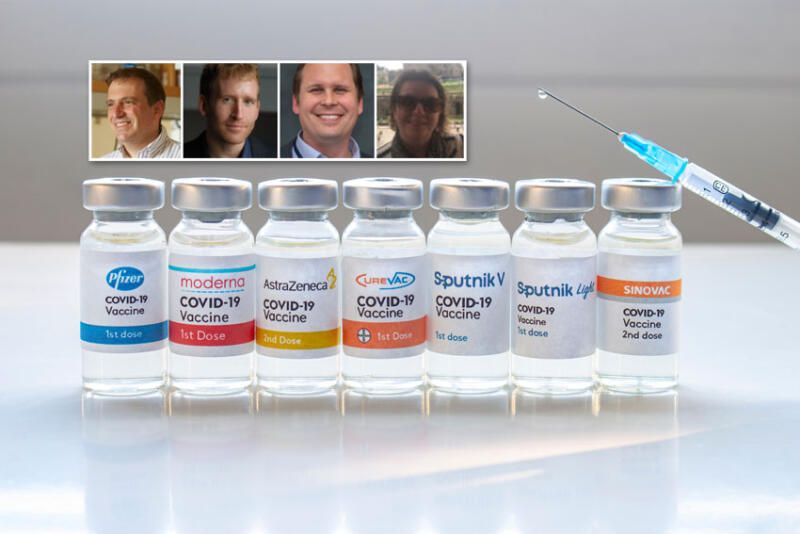Experts Advocate for Global Vaccine Production
(Above, l-r): Dr. Marc Lipsitch, Professor of Epidemiology and Director, Center for Communicable Disease Dynamics, Harvard School of Public Health; Peter Maybarduk, Director, Public Citizen’s Access to Medicines Group; Dr. Ben Neuman, Chief Virologist at the Global Health Research Complex, Texas A&M University; Dr. Rosane Guerra, Department of Pathology, Biological and Health Sciences Center, Federal University of Maranhao, Brazil. (Siliconeer/EMS/Shutterstock)
In the United States, 12-year-olds now can be vaccinated, but new waves and variants of the coronavirus are brutally affecting underdeveloped countries where vaccines are scarce. The COVAX Initiative seeks equity in distributing vaccines.
By Jenny Manrique, Ethnic Media Services
While new daily U.S. infection rates and deaths from COVID-19 drop, much of the world still suffers alarming outbreaks of contagion. Advocates for universal vaccination argue that the country cannot remain in a bubble and the only way to stop the global trend is to invest in vaccine manufacturing capacity.
Peter Maybarduk, director of Public Citizen’s Access to Medicines Group, said political leaders, especially those from developed nations, now must push for sharing the technology that can increase vaccine production.
“Many of the world’s people may not be vaccinated until 2023, if ever, because there is no plan from national leaders for that to happen,” Maybarduk said in a May 14 briefing organized by Ethnic Media Services. So far, only 340 million people have been fully vaccinated worldwide, less than 5% of the world’s population.
To reverse this trend, COVAX, a World Health Organization (WHO) initiative, aims to equitably distribute two billion doses to vaccinate 20% of the world.
It’s a two-part strategy: Rich countries buy into the COVAX pool to produce a vaccines that WHO approves (Pfizer, AstraZeneca, Johnson & Johnson, Moderna, and Sinopharm). Then vaccines are targeted to 92 low- and middle-income countries that cannot access much of the global supply consumed by those wealthy nations.
But so far, Maybarduk said, COVAX has only been able to ship 64 million doses, and it is about $20 billion short of reaching its investment goal.
“The United States is prioritizing its own access to raw materials, which makes it harder for producers abroad to put vaccines on line quickly and demonstrate safety and efficacy to WHO,” Maybarduk added.
Freeing up the production monopoly will require a temporary waiver of TRIPS (Trade-Related Aspects of Intellectual Property), a World Trade Organization agreement, so that any nation can import vaccine technologies without worrying about patents.
But even if patent restrictions are lifted, other nations will need access to vaccine recipes, confidential information for processing chemicals and engineers to work at the facilities.
“Many wealthy governments have been very hesitant to act ambitiously for a global response,” Maybarduk said.
This has left Third World countries like Brazil facing not only insufficient vaccines, but also medicines to control COVID’s worst symptoms. Since vaccinations there began in January with doses of Astrazeneca (Pfizer barely arrived last week), Brazil has immunized only 17% of its population, and rapidly transmitted variants has put it alongside India as one of the nations with the highest number of infections.
The situation in the city of Manaus, the capital of the Brazilian state of Amazonas, is the most worrying, said Dr. Rosane Guerra, a researcher at the Department of Pathology, Biological and Health Sciences Center at the Federal University of Maranhao.
“Around 70% of the people there have tested positive for COVID,” she said. “We know that more than 50% of cases are caused by the PI variant, and that it is more violent at the vascular level than the other lineage. When we have a lot of people infected, the possibility to have new variants increases every day.”
Manaus suffers from extreme shortages of supplies, oxygen, intensive care unit beds and personal protective equipment, and, Dr. Guerra added, the situation is aggravated because there is no decisive action from the Minister of Health “who does not have a knowledge about the situation and doesn’t want to take proper steps to resolve it.”
Also, Brazil President Jair Bolsonaro, despite being infected, believes the virus is a “small flu” and that the pandemic is not severe, so “every day he tells people to go out without masks and use unsuccessful drugs to control the disease,” she said.
No masks
Meanwhile in the United States, the Centers for Disease Control has said fully vaccinated people can stop wearing masks in most settings, something that experts observe with caution.
Dr. Marc Lipsitch, epidemiology professor and director of the Center for Communicable Disease Dynamics at Harvard’s School of Public Health, believes the CDC’s new guidance will have many implementation challenges, given that in the United States “your vaccine status is a private matter. The social barriers to transmission will be lower, but hopefully the vaccine barrier will continue to grow.”
However, Dr. Lipsitch added, that given the levels of reluctance to get the vaccine and continuing access challenges, it’s “very unlikely that as a nation we will reach the required coverage of 85% or 90% to achieve herd immunity,” in which transmission becomes nearly impossible and the virus essentially disappears. “The hope is that if we can keep high enough vaccine coverage for really vulnerable people, the scale of the damage will be much less.”
He feels that vaccinating 12- to 15-year-olds now in the United States is “a use of scarce vaccines that are much more needed in other high-risk places like South Asia.”
For Dr. Ben Newman, chief virologist at the Global Health Research Complex at Texas A&M University, another a global solution is to vaccinate the entire population within a particular window, say six months or a year.
“When people make the calculation about whether to get vaccinated, they’re thinking of the original versions of the virus, but there is a 100% chance that you will run into something that grows faster and has the potential to spread farther and perhaps hit harder,” he said.
Dr. Newman, who sequences viruses in his laboratory, recently found that among the 44 most contagious variants identified in other parts of the world, some are in Texas.
“As people start to read out more of these genomes, we’ll see that the virus is changing in unexpected ways,” he said. “We have to take it (the vaccine) collectively, and not in small groups or with impartial measures, as we have done up to this point,” he concluded.


